Internal memory in the computer is the memory that is directly accessible by the processor without accessing the input-output channel of the computer. The internal memory is accessed by the processor over the system bus.
In the section ahead we will discuss types of internal memories in computers and we will also look at the technique of error correction for internal memory in order to enhance the reliability of the internal memory.
What is Internal Memory?
Computer memory can be classified either as internal memory or as external memory. The internal memory is the one that is directly accessible to the processor via system bus and the external memory is accessed via input-output channels of the computer.
Internal memory is also referred to as the primary memory or the main memory of the computer. The internal memory is used to hold the instructions or data that is currently being executed.
The internal memories of the computer are made up of semiconductor material usually silicon. This memory is costlier and is usually small in size as compared to the external memory.
In our previous content, the semiconductor RAM memories we have discussed the internal organization of the semiconductor main memories where the basic elements of the memory are the memory cell.
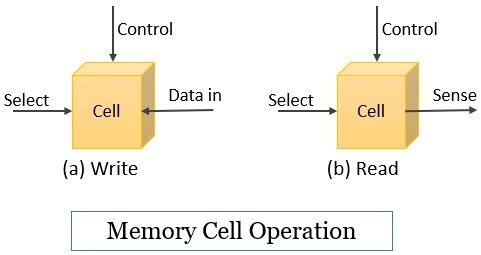
Though there are different techniques to build the semiconductor main memory or internal memory all the semiconductor cells share some common properties as discussed below:
- Every memory cell exhibit two states which represent binary 0 and 1.
- Every memory cell can be read to sense the state it is representing.
- Every memory cell can be written to set it to a particular state i.e., either 0 or 1.
Every memory cell has three lines of access select, control, and read/write. The select line indicates whether the particular memory cell has been selected for the read/write operation or not. The control line indicates whether it is a read or write operation.
For writing the cell an electrical signal is passed through the read/write line which sets the cell’s status to 0 or 1. While reading the same read/write line is used to output the cells state.
Types of Internal Memory
The internal memory of a computer can be classified as RAM, ROM, and cache memory.
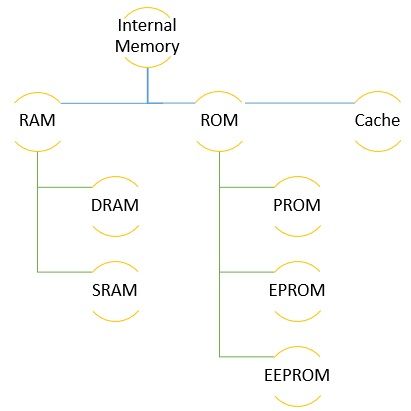
Random Access Memory (RAM)
The RAM memory is the fastest but is a volatile memory. That means to retain its content the RAM memory has to be provided with a constant power supply. Once the power supply to this memory chip is switched off this memory chip loses all its content.
It is easy to read data from and write data into the RAM memory. The data is read or written into the RAM memory using the electric signals. Further, the RAM memory has two other forms DRAM and SRAM.
In dynamic RAM (DRAM) the memory cells are made using capacitors. When the capacitors are charged the value of that memory cell is considered as 1 and when the capacitor has discharged the value of that memory cell is considered as 0. That means the charged or uncharged capacitor represents the binary 1 or 0 respectively.
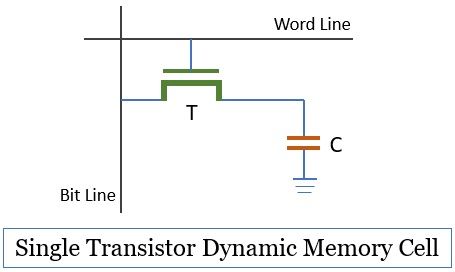
The capacitor automatically discharged after a period so to retain the data in the capacitor it must charge periodically.
In static RAM (SRAM) the memory cell is implemented using the two inverters that are cross-connected to form a latch and this latch in turn is connected to two-bit lines which are connected to two transistors. Here the transistors act as a switch that can be closed and opened under the control of the word line.
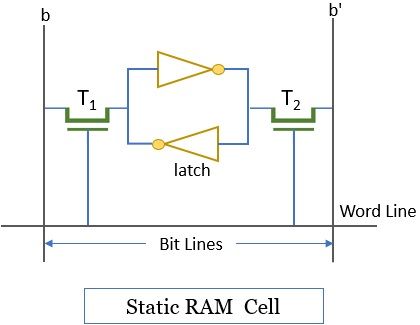
The transistors of a memory cell are switched on to perform the read and write operation on that particular memory cell. Well, both forms of RAM are volatile and require a continuous supply of power to retain their bit value.
Read-Only Memory (ROM)
Read-only memory (ROM) is a non-volatile memory which means the memory cells of this memory chip do not require a power supply to retain its bit value. As this is a read-only memory the bit values of this memory can only be read and not be written or modified.
The figure below shows the structure of a ROM memory cell where the bit value of the memory cell is 0 if the transistor is at a ground level otherwise it is 1.
The bit line is connected to the power supply via a resistor. To read the value of the memory cell the word line is activated which connects the transistor to the ground. This drops the voltage of the bit line to 0 if the transistor is connected to the ground. If there is no connection between transistor and ground the bit line remains at high voltage indicating 1. The state of the memory cell at the connection to the ground is defined during the chip fabrication.
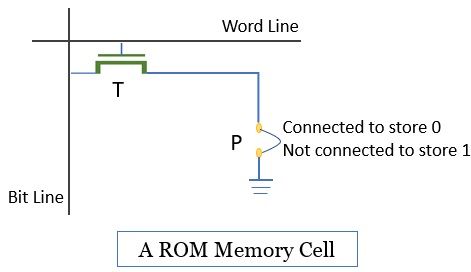
The ROM memory can be used for microprogramming, such as for storing library subroutines, system programs, function tables. The advantage of this internal memory is that the required data or the program is always present in the internal main memory and it is not required to get the data loaded from any secondary memory like in RAM.
On the ROM memory chip, the data or program is embedded during the chip fabrication so it leads to a large fixed cost whether you are fabricating a single copy or more. And even there is no scope for an error of even a single bit as it will ruin the entire batch of ROMS.
Like RAM the ROM also has some other forms such as programmable ROM, erasable programable ROM, electrically erasable programable ROM, and flash memory.
The programable ROM (PROM) is used when few ROMs are required with a specific memory content. PROMs can be written only once using electric signals.
The erasable programable ROM (EPROM) can be read and written using electrical signals. Well before a write operation is performed the memory content of this memory chip are erased to reatin its initial state by exposing the memory chip to the ultraviolet rays.
The EPROM can be erased and update repeatedly and like ROM and PROM, it retains its memory content even if there is no power supply. Compared to ROM and PRM the EPROM is more expensive.
The electrically erasable programable ROM (EEPROM) is the ROM memory that can be erased selectively and written multiple times. Unlike the EPROM where the entire data gets erased when exposed to the ultraviolet rays.
In EEPROM the selective data can be erased without removing the memory chip from the system as with the high than normal electrical voltage the data be erased. The EEPROM is a little complex when compared to the EPROM as it requires different electrical voltage to erase the data.
Flash memory functionally and costs wise lies between EPROM and EEPROM. In flash memory, it is possible to write the entire block of cells. Before writing into the flash memory the block of cells has to be erased, unlike the EEPROM where the byte level erasure is performed. The erasure of flash memory is faster.
Cache Memory
The cache memory is a volatile memory that loses its memory content once the power supply to the memory unit is interrupted. The cache memory keeps the copies of the recently accessed information from the main memory.
Whenever the same information is required again it is accessed from the cache memory which enhances the performance of the system. In this way the cache memory stores the frequently use information. The cache memory is faster and costlier and smaller than RAM memory.
So, these are the internal memories of the computer which are faster smaller, and costlier than the external memories. Usually, the internal memories of the computer are made of semiconductor material that has the technology to speed up access to the memory content.

Leave a Reply